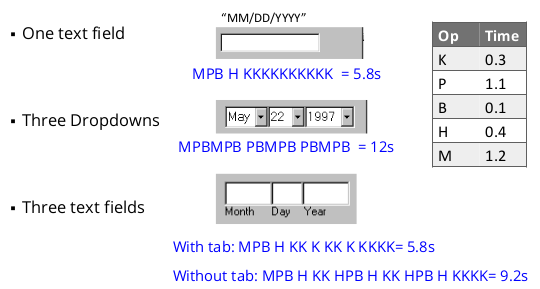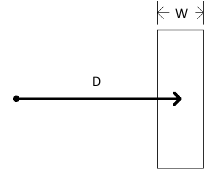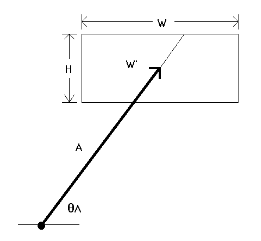Input Performance
Input Performance Models
- Create a model of how people use input devices and interfaces to predict time, error, fatigue, learning etc.
- The goal is to be able to evaluate different designs before building them
Keystroke Level Model (KLM)
- Describe each task with a sequence of operators
- Sum up times to estimate how long the task takes
Operator types
K - Keystroke = 0.08 - 1.2s
P - Pointing = 1.10s
B - Button press on mouse = 0.1s
H - Hand move from mouse to/from keyboard = 0.4s
M - Mental preparation = 1.2s
- KLM is simplified GOMS, so sometimes called KLM-GOMS
- Can be used to compare the performance time of different UI components

KML with Mental Operators (M)
- People need to think about something before doing it
- Identify when people have to stop and think M
- Difference between actions using cognitive conscious and cognitive unconscious
- Insert M when people have to
- Initiate task
- Make a strategy decision
- Retrieve a chunk from memory
- Find something on the display
- Think of a task parameter
- Verify that a specification/action is correct
- Add M in front of any action if the user is novice (vs. expert)

Drawbacks
- Sometime estimates are out of date
- Some time estimates are inherently variable
- Doesn't model errors, learning time etc.
- Doesn't model pointing very well
- Some device are faster than the others
Fitts' Law
- Published in 1954
- A predictive model for priting time considering device, distance and target size
- Based on rapid, aimed movements
- Works for many kinds of pointing devices
- Finger, pen, mouse, joystick etc.
By Paul Fitts
- Psychologist at Ohio State University
- Early advocate of user-centered design
Larger distance => longer time
- Smaller sized target => longer time
- This is Fitts' law
MT - movement time
D - distance between the starting point of the center of the target
W - constraining size of the target
a, b - characterstics of the input device

IP (Index of Performance)
Can be characterized by
ID (Index of difficulty)
For 2D targets

- To determine the "W" in Fitts' Law, we take the minimum of W and H
Context vs. Pie Menus
- Context menu lowers D, but some items are closer than others
- Pie menus give all items same D
Motor Space vs. Screen Space
Dynamically change CD Gain based on position of cursor
- Make the cursor move slowly when over the button
- This makes the button larger in motor space while remaining the same in screen space
The OSX dock expands in visual space but not motor space
- Selecting an item on the expanded dock is no easier than the default dock according to Fitts' law
Steering Law
- An adaptation of Fitts' Law
- Developed by Zhai and Acott
Choose a paradigm which focuses on steering between boundaries
Subjects passed a stylus from one end to the other
- As fast as possible
- Between each goal
- Several trials with different amplitudes (A) and widths (W)
- Same law as Fitts' tapping task
Only one goal
With N goals